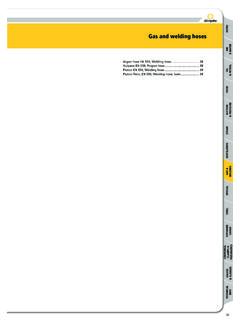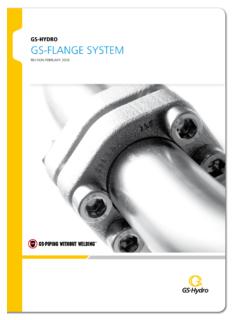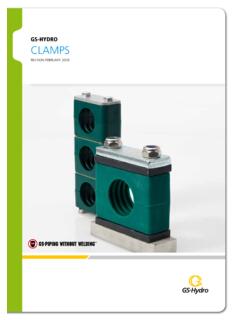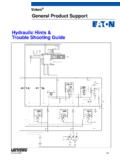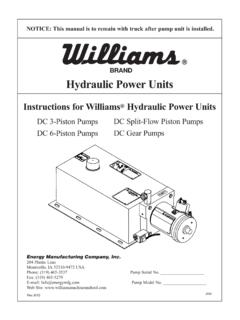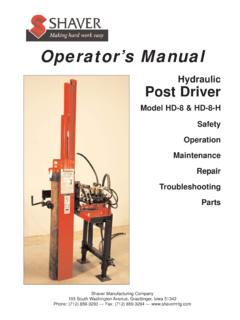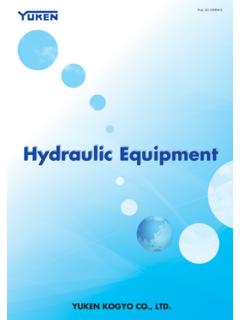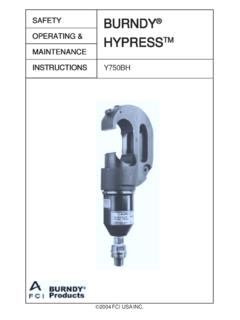Transcription of HYDRAULIC PIPING STANDARD HANDBOOK - GS-Hydro …
1 HYDRAULIC PIPING STANDARD HANDBOOK . Revision 1. Preface We aim to fill a gap in technical literature. At this moment there are no HYDRAULIC PIPING stand- ards available which cover different pressure classes and PIPING materials as well as being gener- ally suited for all applications. The authors of this HANDBOOK have several decades of experience in hundreds of non-welded PIPING projects all over the world in segments such as offshore, marine, steel, mining and testing (just to mention a few). HYDRAULIC PIPING STANDARD HANDBOOK is intended for professionals working within industries where HYDRAULIC PIPING is used. This HANDBOOK offers relevant information in one package for anyone installing or using non-welded HYDRAULIC PIPING systems. This HANDBOOK gives easy-to-use guidelines and compiles all relevant information in one place instead of having to look it up from several different sources.
2 One of the main advantages in this HANDBOOK is the standardization of PIPING classes which enables the reduction of pipe sizes/wall thicknesses as well as components. This HANDBOOK contains information and standards that assist in the engineering process of a non-welded PIPING system through non-welded HYDRAULIC PIPING standards , recognized Marine Classification Societies' main rules, relevant technical guidelines and HYDRAULIC symbols. We appreciate your assistance in perfecting this HANDBOOK . Please send any suggestions or TO BE CUTTED OFF. possible corrections to Please specify in the subject field HYDRAULIC PIPING STANDARD HANDBOOK . Thank you! 3. HYDRAULIC PIPING STANDARD HANDBOOK REVISION 1 / 0414. 4. Disclamer In the professional judgment of GS-Hydro , the accuracy and level of detail of the information presented in this HANDBOOK are suitable for use by professional users with the required expertise and experience.
3 The information is believed to be correct at time of release of this edition of the HANDBOOK . However, correct use of this HANDBOOK and verification of relevant information for the job at hand is the responsibility of the user. GS-Hydro is not responsible for any direct or indirect damage caused by possible mistakes or the wrong application of the information. The latest rules and instructions must always be checked to ensure the safety of the people, equipment and environment involved. GS-Hydro prohibits repro- duction and distribution of this material for use by third parties or for commercial gain. TO BE CUTTED OFF. 5. HYDRAULIC PIPING STANDARD HANDBOOK REVISION 1 / 0414. 6. Content Preface .. 3. Disclaimer .. 5. Content .. 7. How to Use this HANDBOOK .. 8. 1. PIPING standards .. 11. Carbon Steel PIPING : 16 bar - 420 bar .. 13. Stainless Steel PIPING , AISI: 16 bar - 420 bar.
4 37. Stainless Steel PIPING , Ice Class -50 C: 16 bar - 420 bar .. 61. 2. Relevant Rules and Guidelines from Classification Societies .. 85. American Bureau of Shipping .. 87. Det Norske Veritas .. 105. Germanischer Lloyd .. 115. Lloyd's Register .. 135. 3. Flushing and Pressure Testing Procedure .. 153. TO BE CUTTED OFF. General Guidelines for Pressure Testing and Flushing of HYDRAULIC Systems . 154. Pressure Testing .. 156. Flushing .. 159. Schematics Instructions .. 164. 4. Useful Technical Information .. 167. PIPING System Design .. 168. General .. 168. Fluid (Oil) Velocities .. 170. Pressure Loss .. 171. Mechanical Design .. 171. Pipe and Tube Materials .. 171. Fitting and Flanges .. 172. Hoses and Hose Couplings .. 173. Pipe Supports .. 174. Cleanliness .. 174. ISO 4406:1987 and ISO 4406:1999 .. 175. NAS 1638 .. 176. SAE AS4059 .. 176.
5 Attachments .. 177. 5. HYDRAULIC Symbols .. 189. 7. HYDRAULIC PIPING STANDARD HANDBOOK REVISION 1 / 0414. How to use this HANDBOOK HYDRAULIC PIPING STANDARD HANDBOOK is a compilation of standards and information which is useful when engineering HYDRAULIC PIPING systems. This HANDBOOK offers information and guidelines according to international standards and Classification Societies' rules which are meant to assist in the standardization of HYDRAULIC PIPING as well as to act as the foundation for project detail engineering. Understanding Projects It is important to understand the basics of project business, in other words, the processes behind every project in the offshore, marine and land-based businesses. Below are presented three different project types in simplified steps. Land-based project Marine project Investment decision Feasibility Mill specification Outline project Project development OEM specification /.
6 Reference Contract project Basic engineering Basic design Detail engineering Detail design Construction Construction & and installation comissioning Offshore project Operation Operation Concept engineering FEED. Basic engineering Detail engineering Construction and installation Comissioning Operation From a HYDRAULIC PIPING viewpoint the most important issue in every project is the basic engineering which involves mak- ing decisions on how the project will be executed later on (such as detail design, installation and commissioning). Even in a basic design stage, clear and exact decisions are critical for the success of the next project stage. If basic design is done in a very light or unclear manner there will be difficulties later on when these decisions and technical specifications need to be followed. One of the main goals of this HANDBOOK is to assist in the basic engineering or basic design.
7 Very detailed information is needed to execute the basic engineering in a way that will create success in the later stages of detail engineering, instal- lation and commission. 8. How to use this HANDBOOK For the project input phase, basic engineering for HYDRAULIC PIPING is based on the following simplified steps: Define oil flow, Define how Define Choose materials pressure etc. to PIPING system cleanliness and and connection help define connects to other flushing technology PIPING size equipment requirements Next comes detail engineering which determines the detail level of final pipe routing, material, components etc. The HYDRAULIC PIPING STANDARD HANDBOOK assists in the above mentioned engineering process by providing relevant information and standards for this project input phase. This is when the PIPING requirements are defined such as desired working pressure, maximum pressure, maximum flow rate, acceptable pressure drops and classification requirements.
8 PIPING standards - Chapter 1. PIPING standards are based on three different conditions: Normal dry indoor conditions (carbon steel). High humidity outdoor conditions (stainless steel). Ice conditions -50 C (stainless steel). Pipe sizes are standardized to reduce the numbers of pipe sizes. The tables give basic information for normal STANDARD pipe sizes with flow and pressure. All pipe sizes have been matched with a recommended non-welded connection technology while fulfilling Classification Society standards . The chosen seals, valves and hose-assemblies are the ones that are most commonly used. In high humidity outdoor conditions with high pressure (>315 bar) and large pipe sizes (>4") duplex or superduplex PIPING material can alternatively be used (this is intentionally not covered in this HANDBOOK ). Their use should be considered separately each time (take into consideration the application, material and manufactur- ing method).
9 TO BE CUTTED OFF. Rules and guidelines for HYDRAULIC PIPING from corresponding Classification Societies Chapter 2. This presents a selection of the main rules from four Marine Classification Societies (American Bureau of Shipping, Det Norske Veritas, Germanischer Lloyd, Lloyd's Register). It gives a basic understanding of the main rules and guidelines for HYDRAULIC PIPING which need to be considered in the PIPING project. The authors do not have any liability for context or possible changes to the rules so it is assumed that the reader always checks for the latest updates directly from the Classification Societies. Flushing and pressure testing Chapter 3. Flushing is a critical step in the HYDRAULIC PIPING procedure as it ensures the cleanliness of the PIPING . Given the variety of HYDRAULIC systems, it is important that the relevant professionals are present at a very early stage to set the right goals for the level of purity.
10 The desired level of purity can be influenced by different types of valves (proportional or servo valves), pumps, cylinders, motors, and oil viscosity. Useful technical information Chapter 4. An overview of the most important issues involved in HYDRAULIC PIPING design and installation. HYDRAULIC symbols Chapter 5. Basic symbols used in HYDRAULIC engineering including those according to SMS and Cetop. 9. HYDRAULIC PIPING STANDARD HANDBOOK REVISION 1 / 0414. 10. PIPING standards Carbon Steel PIPING : 16 bar - 420 bar .. 13. Stainless Steel PIPING , AISI: 16 bar - 420 bar .. 37. Stainless Steel PIPING , Ice Class 50 C : 16 bar 420 bar .. 61. TO BE CUTTED OFF. 11. HYDRAULIC PIPING STANDARD HANDBOOK REVISION 1 / 0414. 12. Carbon Steel PIPING : 16 bar - 420 bar Basic Connection Table .. 15. Carbon Steel 16 bar / 250 Psi .. 16. Carbon Steel 50 bar / 750 Psi.

